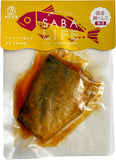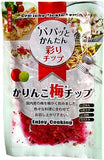
MIXED MOUNTAIN VEGETABLES
(山菜ミックス水煮)
Producer: Suzuki Seika
Prefecture: Akita
Sansai (lit. “mountain vegetables”), which include a wide variety of plants, offer a range of diverse flavors, textures and nutrients for buddhist monks and are typically picked in the early spring just after the snow melts.
To create these Mixed Mountain Vegetables, which was a favorite from our July Vegan Zen Nourishing Essentials Care Package, our producer Suzuki Seika combines seven sansai varieties, including warabi (bracken), which are the young, long unopened heads of ferns, zenmai (fiddlehead ferns), nameko, a type of small, brown mushrooms with a slightly slimy coating, fuki (butterbur), whose stalks resemble celery and have an earthy, bitter flavor, bamboo shoots, and two rare sansai vegetables: mizu and saku. Mizu grows in moist, deeply forested places in the mountains, and is a member of the nettle family. Saku stems are eaten and have a very bitter flavor so are salted to mellow the taste. All the vegetables in this mix are harvested in the early spring by Suzuki Seika’s team of more than 160 foragers.
Ingredients: Warabi (bracken fern), nameko mushrooms, mizu (Japanese nettle), fuki (butterbur), saku (wild Japanese celery), fiddlehead fern, bamboo shoot, plum vinegar
Suggested uses: Boil for 1-2 mins before using. Enjoy as is with ponzu or miso. Use as a topping for warm noodle dishes, pasta or pizza, or in stir fries or the Takikomi Gohan (Mixed Rice) recipe provided.

NAMA-MISO TUNA CHILI OIL
(鮪の生らー油)
Producer: Yonaguni Suisan Kako
Prefecture: Yonaguni Island
This Nama-Miso Tuna Chili Oil, a favorite from our always popular June Okinawa Nourishing Essentials Care Package, combines locally-sourced bonito (tuna) flakes with umami-rich nama-miso (raw miso that has not been heat-treated to stop the fermentation process - a living food!) and a variety of island spices, sugar and salt to create a delectable chili oil full of Okinawan flavor. The bonito are sourced from the Kubura Fishing Port with a quality drawn from the Kuroshio Current - named after the deep blue color of its waters. Each bonito is carefully dried one by one to produce the richest flavor. The natural sea salt comes from the coral seas of Ishigaki Island, while the kokuto (brown sugar) is from Hateruma island and is known for being rich in minerals with a deep licorice flavor. Our producer, Yonaguni Suisan Kako, invites you to enjoy the exquisite harmony of Okinawa’s churuami (the beautiful graceful ocean) and all the island’s blessings.
Ingredients: Sesame oil, miso (non GMO-soybean, rice, salt, barley, wheat), bonito flakes, pepper, kokuto (brown sugar from Hateruma island), garlic flakes, salt (from Ishigaki island)
Suggested uses: Use as a sauce for gyoza, ramen, cold noodles, fried rice, stir fries and pasta. Can also be used as a spread on bread or as a topping for rice or tofu.

NUKA PICKLED HESHIKO SABA (MACKEREL)
(へしこ糠漬)
Producer: Sakita Shoji
Prefecture: Kyoto
Heshiko is a traditional nukazuke (rice bran pickle) that is popular in the Kansai region, particularly in Kyoto. It consists of salted saba (mackerel) that has been pickled in a rice bran starter known as nuka. The pickling process helps to bring out the full flavors of the saba, which has a buttery texture and mild sweetness.
Sakita Shoji, located in the northeastern region of Kyoto, brings this traditional dish to your home in this Nuka Pickled Heshiko Saba which was a favorite in our Fall Kansai Seasonal Delights Care Package. They carefully pickle their heshiko using a unique aging method that preserves its full depth of flavor. To enjoy this heshiko the traditional way, we recommend making ochazuke, which is a simple yet comforting traditional dish made from steamed rice with savory toppings, such as this fish, partially steeped in green tea.
Ingredients: Saba (mackerel) (domestic), salt, rice bran, chili
Suggested uses: Enjoy on rice (pour tea on top to make ochazuke) or as a snack with sake. Add chopped to rice to make onigiri (rice balls). Put on a cracker with cream cheese, or in salads, fried rice, pasta and pizza. Use as a substitute for anchovies.

UME “KARI KARI” CHIPS
(自然派かりんこ梅チップ)
Producer: Ohtoneduke
Prefecture: Gunma
“Kari Kari” is a colorful Japanese onomatopoeic word meaning “crispy crispy”. Our producer, Ohtoneduke, dries and shaves ume (Japanese plum) into thin crispy flakes to use as a seasoning which was featured in our spring-time favorite April Sakura & Ume Nourishing Essentials Care Package. The natural acidity of the ume is complemented by the herbal flavor of shiso (Japanese basil) and sour pickling ingredients.
The ume comes from Gunma Prefecture, where Ohtoneduke is based. Gunma is known across Japan for its ume. In fact, every year, Ume Festivals are held across Gunma with some parks - like the Misato Ume Garden - boast over 100,000 ume trees which bloom in a spectacular display filling the air with their sweet fragrance.
Ingredients: Ume (Japanese plum from Japan), shiso (Japanese basil from Japan), pickling ingredients (salt, vinegar, sugar, plum vinegar, katsuobushi extract, fermented seasonings), vegetable pigment
Suggested uses: Sprinkle on rice as furikake (Japanese seasoning), or use as a seasoning for pasta, vegetables, or eggs.

HAKATA SALT YOKAN
(伯方の塩羊羹)
Producer: Besshiame Honpo
Prefecture: Ehime
Yokan is a popular form of wagashi (traditional Japanese sweet). The wagashi culture flourished in the Edo Era as local sugar production increased, sparking the creation of a wide variety of wagashi that were as beautiful as they were delicious. In modern day Japan, yokan is still made following recipes that were developed during the Edo Era.
Yokan started as a savory snack introduced to monks in Japan from China. The original recipe relied on gelatin made from mutton, but since Japanese monks can’t eat meat, kanten (agar) was used instead to give it its jelly-like texture. Azuki (sweet red beans) were also added for natural sweetness. Our producer, Besshiame Honpo, also adds a pinch of salt to enhance the sweet taste, and white beans for extra texture - a favorite treat from our May Edo Era Nourishing Essentials Care Package.
Ingredients: Sugar, azuki (red bean) paste, kanten (agar), starch syrup, white beans, salt
Suggested uses: Enjoy as is with coffee or tea (available in our Japanese Green & Specialty Teas: “Ryu” Care Package).

RYUKYU FLAVORED OKINAWA TEA BLEND
(琉球の香り)
Producer: Higaseicha
Prefecture: Okinawa
Okinawa, Japan’s southernmost tropical islands, encompasses two thirds of what was formerly known as the Ryukyu Islands. The Ryukyu Kingdom was ruled as a tributary state of China under the Ming dynasty beginning in the 15th century before becoming a vassal state of Japan after the Invasion of Ryukyu in 1609. It was later dissolved to form Okinawa Prefecture in 1879. Being a central part of the trade network in the region, its culture and food are heavily influenced by East and Southeast Asia.
This Okinawan tea is reminiscent of the diverse flavors of the Ryukyu Kingdom, with a healthy yet flavorful blend of 22 ingredients unique to Okinawa, including wild grasses and reishi mushrooms. It was a favorite from our Okinawa June Nourishing Essentials and Summer Seasonal Delights Care Packages. Just one sip will sweep you away to the tropical islands of Okinawa!
Ingredients: Barley tea, sicklepod tea, hatomugi (Job’s tears), oolong stem tea, wolfberry, chameleon plant tea, hojicha (roasted green tea), cinnamon bark, jasmine tea, gymnema sylvestre, autumn turmeric, kumisukuchin, reishi mushroom, safflower, guava leaf, loquat leaf, persimmon leaf, ginseng, mugwort, plantain, Ryukyu mugwort, candelabra aloe
Suggested uses: Steep 1 tea bag in 150-200ml of hot water, depending on your preferred strength.
